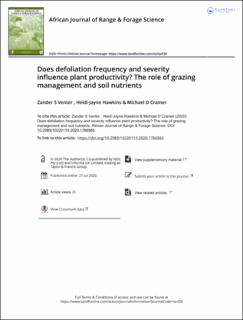Does defoliation frequency and severity influence plant productivity? The role of grazing management and soil nutrients
Peer reviewed, Journal article
Published version

Åpne
Permanent lenke
https://hdl.handle.net/11250/2673866Utgivelsesdato
2020Metadata
Vis full innførselSamlinger
- Scientific publications [1392]
Originalversjon
10.2989/10220119.2020.1766565Sammendrag
Rangeland management approaches, including rotational grazing, rely on assumptions about plant growth responses to the intensity, or severity (sward height) plus frequency, of defoliation. We tested these assumptions at the farm, patch and plant scale using data from a grazing management trial in an Eastern Cape mesic grassland of South Africa along with field plot and glasshouse pot experiments. The grazing trial tested season-long grazing (SLG), four-camp grazing (FCG) and holistic planned grazing (HPG) at equivalent stocking rates over three years. We found that grass growth responses in both potted plants and field plots were reduced under more frequent and severe defoliation but that this was mitigated under elevated soil nutrients, in line with the Compensatory Continuum Hypothesis which predicts that compensatory growth will increase across an increasing fertility gradient. In the farm trial, SLG, which theoretically causes high frequency, low severity defoliation, reduced bare ground cover and increased vegetation greenness with increasing defoliation intensity on nutrient-rich soils. This effect was not present under FCG or HPG and disappeared under very high defoliation intensities and on relatively water- and nutrient-poor soils. Managers are advised to only increase grazing frequency on relatively high nutrient soils, while maximizing recovery on poorer nutrient soils
